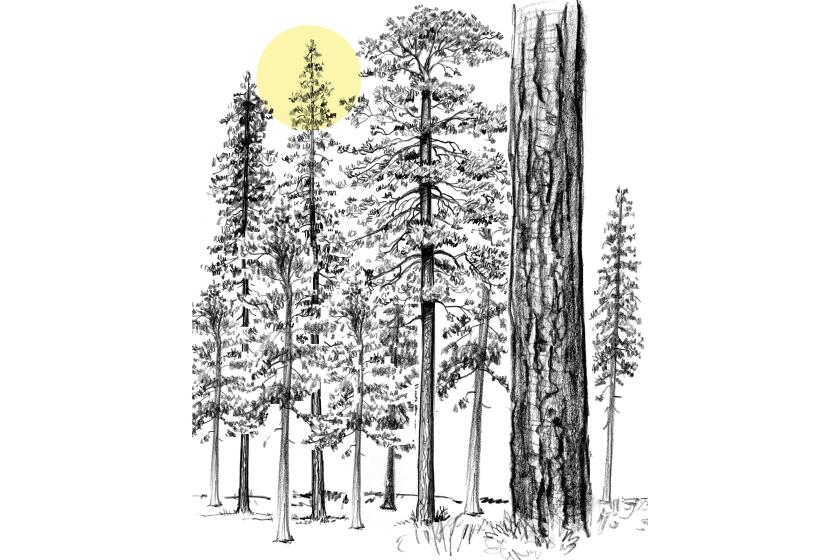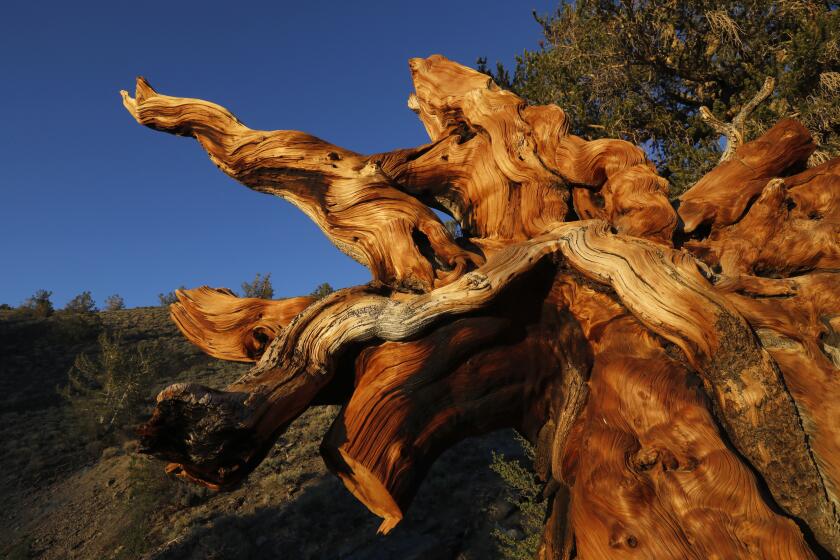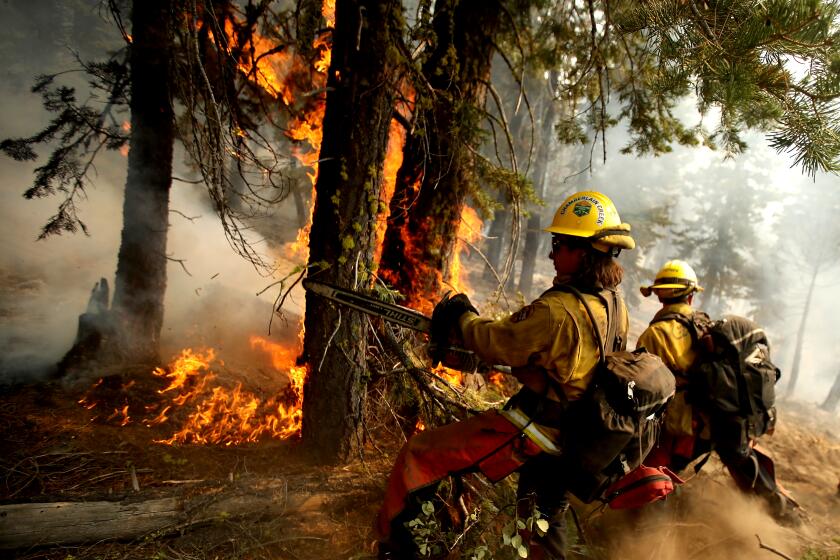Nearly a third of southern Sierra forests killed by drought and wildfire in last decade

- Share via
As climate change continues to transform California’s landscape in staggering and often irreversible ways, researchers have zeroed in on yet another casualty of the shift: the forests of the southern Sierra Nevada.
Between 2011 and 2020, wildfires, drought and bark beetle infestations contributed to the loss of nearly a third of all conifer forests in the lower half of the mountain range, according to a recent study published in the journal Ecological Applications. Eighty-five percent of the southern Sierra’s high-density mature forests either lost density or became non-forest vegetation.
The losses could have grave consequences for California wildlife, including protected species such as spotted owls and Pacific fishers that rely on mature tree canopies for their habitats. Researchers said the findings not only are another indication of the state’s shifting climate regime, but also offer new insights that could help guide forest management and conservation strategies.
“Thirty percent of conifer forests in the southern Sierra Nevada are no longer considered forests,” said Zachary Steel, a research scientist with the United States Forest Service’s Rocky Mountain Research Station and the lead author of the study. “They’re either sparsely treed landscapes or, more often, are transitioning either in the short term or long term to more of a shrubland-type system.”
As California struggles with an increase in extreme wildfires, researchers are studying exactly what a healthy or fire-resistant forest looks like.
The Sierra covers about a quarter of California’s land area, with the southern portion of the range running from Lake Tahoe to Tehachapi. Hundreds of plants and animals call the region home, and the forest helps sequester carbon and store water for the state’s residents.
Steel, who conducted the study as a postdoctoral researcher at UC Berkeley, said the numbers were alarming.
“What’s most concerning is the pace at which this is happening,” he said. “Fire always occurred in these landscapes, drought always occurred in these landscapes ... but the declines are going so rapidly that the succession, or the regrowth, of these forests is not going to be able to keep up.”
The problem is multifaceted, he said. For starters, human-caused climate change is contributing to warmer, drier conditions that are turning once-green forests into brittle tinder and lengthening the window of time in which wildfires can burn each year.
What’s more, thirsty trees are weaker and more susceptible to deadly attacks from bark beetles, which bore into them and chew away at their inner cores. The study found that the combination of drought and beetle attacks caused even greater declines than areas where drought and wildfire overlapped.
But forest management is also part of the story, Steel said, because a century of suppressing wildfires and outlawing Indigenous burning practices has allowed for an unnatural buildup of vegetation in the landscape. While wildfires once regularly simmered along the forest floors, today’s “megafires” are burning at high severity and searing some trees up to the top.
“One of the important takeaways is if we’re going to still have old forests on the landscape, we need to manage what’s left to be more resilient,” Steel said. That includes prescribed burns, mechanical thinning and allowing naturally occurring fires to play out on the landscape when it is safe to do so, he said.
Extreme drought and bark beetles now threaten California’s Ancient Bristlecone Pine Forest, home to Methuselah, a 4,853-year-old bristlecone pine.
Scott Stephens, a professor of fire science at UC Berkeley, said the study makes a good case for active stewardship in the face of climate change.
“If it was actually the smaller-size trees or even medium-size that were dying, I think in some way it would be a different story. But it’s the big ones, and the big ones are already in a deficit in a lot of areas,” he said. “The culmination of these last 10 years has really been much more severe on the largest trees in the landscape, which are actually the ones we need the most.”
But while the loss of so much forestland may be jarring to humans, it’s downright devastating for some creatures that call the Sierra home. California spotted owls, which typically occupy nest sites with at least 70% canopy cover, have fewer options in younger, sparser forests, the study says.
Decades ago, the state began setting aside protected areas for spotted owls and other species in an effort to preserve them. But that strategy may have backfired, as the protected areas too saw a buildup of explosive vegetation. The study found that spotted owl “protected activity centers” experienced a 49% decline in canopy cover, compared with a 42% decline in non-protected areas.
“It appeared to us in our naivete ... that if we just put a box around something and left it alone it would stay the same and we could protect it and we’d be effective at it — and for a long time we were,” said Gavin Jones, a research scientist at the Rocky Mountain Research Station and co-author of the study.
“But this result that we found here, it does I think fly in the face of some of those conventional paradigms, and it raises the question of whether we need to rethink those,” he said. “The places that we’re trying to protect are now more difficult to protect because we’ve been protecting them.”
Jones said that the protections for those areas still serve important purposes and shouldn’t be eliminated, but that the approach could be refined by allowing for some prescribed burns or other methods of management.
To forestall continued loss of such habitats, the study notes, “a shift from a static, preservationist paradigm of habitat conservation to one striving for sustainable disturbance dynamics is likely necessary.”
Wildfires are increasing streamflow throughout the western U.S., raising new threats for public safety and water management, according to researchers.
The losses could have other cascading effects in California, the researchers said, because forests play an important role in the state’s water supply and help with carbon sequestration. Jones said humans still have some control over the outcome — at least when it comes to forest and habitat management.
“The take-home is that there’s still time, but what we’ve been doing isn’t working very well,” he said.
The state is ramping up its efforts, including more than $2 billion in allocated funding for wildfire response and forest resilience projects over the last two years, much of it for forest thinning, prescribed burns and other projects intended to reduce fire risks. President Biden’s Inflation Reduction Act also includes a $5-billion investment in forest management and wildfire risk reduction.
But Steel stressed that climate change is a “threat multiplier” driving big — and often irreversible — disturbances over time.
“With changing fire patterns and with climate change, there’s going to be winners and losers,” he said. “We’re, in this piece, highlighting a couple of the ‘losers’ and trying to figure out how we can put numbers to that, so that we can work toward keeping them from disappearing from this landscape.”










